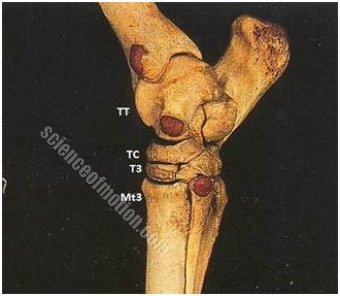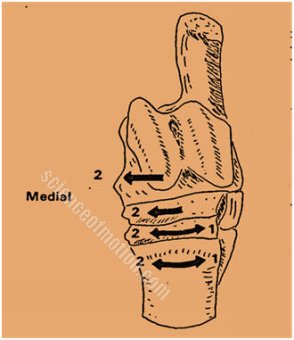False Practices 2
False Practice Two
by
Jean Luc Cornille
Dressage and In hand horse trainer
(Introduction from the transcript for a video from IHTC 6 which is on shoulder-in and shoulder-fore)
“Unfortunately, it is much easier to turn to false practice than to achieve what is correct.” François Robichon de la Gueriniere (1688-1751)
If Monsieur de la Gueriniere felt that he had to address the “false practice” issue, it is that already at the eighteen century, trainers focused on the gesture instead of coordinating efficiently the horse physique for the athletic demand of the performance. However, at the eighteen as well as the nineteen centuries, the knowledge of equine physiology was at its infancy and therefore, “what is correct” was mostly what the author believe and “false practice” was everybody else’s opinion. Advances in scientific knowledge provide a more accurate definition of “what is correct” verses “false practice.” False practice is making dysfunctional athletes executing movements for which their physique is not adequately coordinated. What is correct is preparing efficiently the horse’s physique for the athletic demand of the performance.
Recently, a team of brilliant scientists introduced a new and pertinent concept of equine locomotion as well as performances. “The muscular work of galloping in horses is halved by storing and returning elastic strain energy in spring-like muscle-tendon units.” (Alan M. Wilson, M. Polly McGulgan, Anne Su & Anton J. van den Bogertt, Department of Biomedical Engineering, Cleveland Clinic Foundation - 2001) Moving away from the classical perception, “muscles move bones,” new generations of studies demonstrate that a great part of the horse’s locomotion and performances results from the recoil of elastic strain energy stored in the long tendons. “Most of the length change required for the work of locomotion, occurs not in the muscle fibre themselves but by elastic recoil of the associated tendons and muscles aponeurosis.” (The role of the extrinsic thoracic limbmuscles in equine locomotion. R. C. Payne, P. Veenman and A. M. Wilson. J. Anat. (2005) 206, pp 193-404)
The long tendons of the equine lower limbs are ideal for explanation. Under the strain of impact forces and during the first half of the stride, the tendons elongate storing energy that is used propelling the limb into the swing phase. During this work, the muscles connected to the long tendons resist elongation increasing the strain on the tendons and therefore their capacity to store elastic strain energy. For a great part the amplitude of the hind and front limbs action is the outcome of this dynamic phenomenon. What is correct is a coordination of the whole physique optimizing the magnitude of elastic recoils. False practice is stimulating artificial limbs action with one or two whips, or having the horse mimicking a trainer lifting his or her knees or any other body gesture. These false practices are not harmless. They dissociate limbs movements from vertebral column mechanism, creating dysfunction and altering the whole dynamics of the locomotor system. 

The beauty and the soundness of proper locomotion as well as performances demand precise synchronization between limbs kinematics and vertebral column mechanism. Altering such coordination induces abnormal stresses on the limbs joints which, over a period of time cause failure. The concept is easy to understand looking at the hock joints. The hock is composed of four joints placed one above the other. As the hock flexes and extends, inward rotation occurs within the different joints in the direction medial to lateral and lateral to medial.
Inward rotations of the two upper joint are synchronized with flexion and extension of the stifle. Inward rotations of the two lower joints are synchronized with down and up translation of the fetlock. When, responding to a touch of the whip, the lower leg impacts too early, the rotation between the upper and lower joints is off synchronization and arthritis is likely to occur between Mt3 and T3.
With advances in scientific knowledge, the concept of tendons storing and using elastic strain energy is no longer limited to the long tendon of the horse lower legs. “In a sense, because the muscle is composed of both muscle fibers and tendinous materials, all of these structures must be collectively ‘tuned’ to the spring properties for the muscle-tendon system to store and recover elastic strain energy during locomotion.” (Eccentric Muscle Contractions: Their Contribution to Injury, Prevention, Rehabilitation, and Sport. Paul C. LaStayo, PT, PhD. John M. Woolf, PT, MS, ATC. Michael D. Lewek, PT. Lynn Snyde-Mackler, PT, ScD. Trugo Relch, BS. Stan L. Lindstedt, PhD. Journal of Orthopaedic & sports physical therapy. 557-571. Volume 33, NUMBER 10, October 2003) Most muscles, include back muscles have the capacity to store and recover elastic strain energy within their belly.
Riding and training techniques as well as teaching approach and therapies need a paradigm shift. Education as well as rehabilitation demand sophistication instead of relaxation, nuances in muscle tone instead of stretching, frequency instead of intensity. Riders’ movements need to be reduces instead of magnified. Large movements of the rider’s back as well as hands and legs gestures stimulate chaotic strains of the muscles’ tendinous components. The whole theory of “more is better,” more swing of the horse’s back, more suppleness of the neck, more stretching, more limbs manipulations, more rider movements, are in contradiction with actual understanding of the equine vertebral column and limbs mechanism. Instead of a contortionist, the horse’s physique functions more like tight rope dancer, sophisticated control of forces through infinite variations of nuances in muscle tone but minimum gestures.
A female gymnast on a balancing beam performs via sophisticated control of her physique. Both, the tight rope dancer and the gymnast perform and control balance simultaneously. As they volte above their narrow base, they show superb amplitude as well as suppleness. However, they never contract and never relax, (false practice,) as both extremes would lead to painful crashes. Instead, they perform through nuances in muscles tone allowing suppleness, amplitude, elastic recoil and balance control, (what is correct.) As well, a horse simultaneously performs and controls balance. A horse does not contract or relax as both extremes would cause heavy impact on the forelegs, causing over time, damages as bad as falling form the balancing beam or the rope.
Nobody like changes and therefore arguments are always about resisting changes. Even if of no value, a common objection is, “but everybody else does it this way.” Interestingly, the response is in the classic literature, “it is much easier to turn to false practice than to achieve what is correct.” The same classic literature set the tone about the need for questioning old ideas in the light of new knowledge. Colonel Hans von Heydebreck, who edited the fifth version of Gustave Steinbrecht’s “Horse Gymnasium,” wrote in its preface, “There are few theses which don’t hold well in the face of new scientific discoveries.”(1935) Already in 1935, a true classical rider understood that respect for tradition demanded updating classical views to new knowledge. Steinbrecht research is particularly pertinent in this discussion. The German author created the concept of the shoulder for. It was a vision, which has been downgraded by false practices into useless compulsory. Judging standards define and reward “shoulder for” as a shoulder in with little angle. This is not even remotely close from Steinbrecht’s idea. First of all, Gustave Steinbrecht did not presente the shoulder for as a movement but instead as a “concept”. Steinbrecht’s idea was that the horse’s shoulders are narrower than the haunches. Steinbrecht suggests that horses travel in the schooling ring shifting the outside foreleg in front of the outside hind leg. Steinbrecht observed that if the rider keeps the horse haunches absolutely straight. I repeat, “absolutely straight,” the horse executes the move bending the thoracolumbar column laterally. Steinbrecht also observed that doing so, the horse gained freedom in his trot.
Steinbrecht discovered in fact, the phenomena of transversal rotation, “In the cervical and thoracic vertebral column, rotation is always coupled with lateroflexion and vice versa.” (Jean Marie Denoix, 1999). A century and half earlier François Robichon de la Gueriniere discovered also the relation between lateral bending and transversal rotation. A century prior Monsieur de la Gueriniere, the Duke of Newcastle made the same discovery. None of these classic authors refers to any transversal rotation because the phenomenon was not discovered at their time. They were precursors who did not have available, the scientific knowledge that would have substantiated and further explained their discovery.
These three men’s genial idea has been turned into false practice because tradition repeats words without understanding their meaning. In order to fully understand classic authors’ meaning and therefore, “what is correct”, one needs analyzing their words in the light of new knowledge.
The IHTC’s five first installments updated your understanding of the equine physiology to actual knowledge. Because of this knowledge, you can now understand the body coordination allowing the horse to fully benefit from the gymnastic effect of the movement. Dressage movements are primarily gymnastic exercises. They have been conceived to develop and coordinate the horses’ physique. When François Robichon de la Gueriniere invented the shoulder in, dressage tests did not exist. Equestrian presentations were mostly about the airs above the ground. Exactly like the shoulder for, the shoulder in was conceived as a gymnastic exercise. “This lesson produces so many good results at once that I regard it as the first and the last of all those which are given to the horse in order to make him develop complete suppleness and perfect freedom in all part of his body.” ( Ecole de cavalerie, 1731)
Remember Vincent van Ghoge’s statement, “I dream my painting and then I paint my dream.” Once you have clearly in mind the body coordination preparing efficiently the horse’s physique for the athletic demand of the performance, you can “paint” the body coordination. You can lead the horse’s brain to the body coordination allowing full benefit of the gymnastic exercise. This of course, is a perquisite for therapy. Dressage movements have become figure of style presented and judged in the dressage ring. Judging standards describe how the movements are supposed to look like. They do not provide much information about the necessary body coordination. Without adequate knowledge of the appropriated coordination of the horse’s physique, judging standards lead to false practice where dysfunctional athlete perform the move out of their talent and their rider’s skill but only as a shadow of what they could do if their physique was properly developed and coordinated. The capacity of creating appropriated coordination is what classical masters refer to as “what is correct.”
During the second half of the IHTC, we are going to study in details all dressage movements, starting with the shoulder for and the shoulder in. The study includes, who created the movement, what was the author’s original idea, how the movement evolved over time, what is the coordination of the horse’s physique allowing full benefit of the muscular development and coordination that the movement stimulate. By creating such coordination, you are offering to your horse the gift of soundness and the capacity to perform at its utmost potential. We have purposely selected a computer animation showing the horse’s main muscles involved during each sequence of the jump. The reason is that dressage movements are primarily gymnastic exercises. Their true purpose is developing and coordinating efficiently the horse physique for the athletic demand of the performance, whatever the performance is shoulder in, canter pirouette or jumping.
Jean Luc Cornille
Science Of Motion
Click for Information on IHTC Course


 twitter
twitter facebook
facebook google
google stumbleupon
stumbleupon pinterest
pinterest linkedin
linkedin